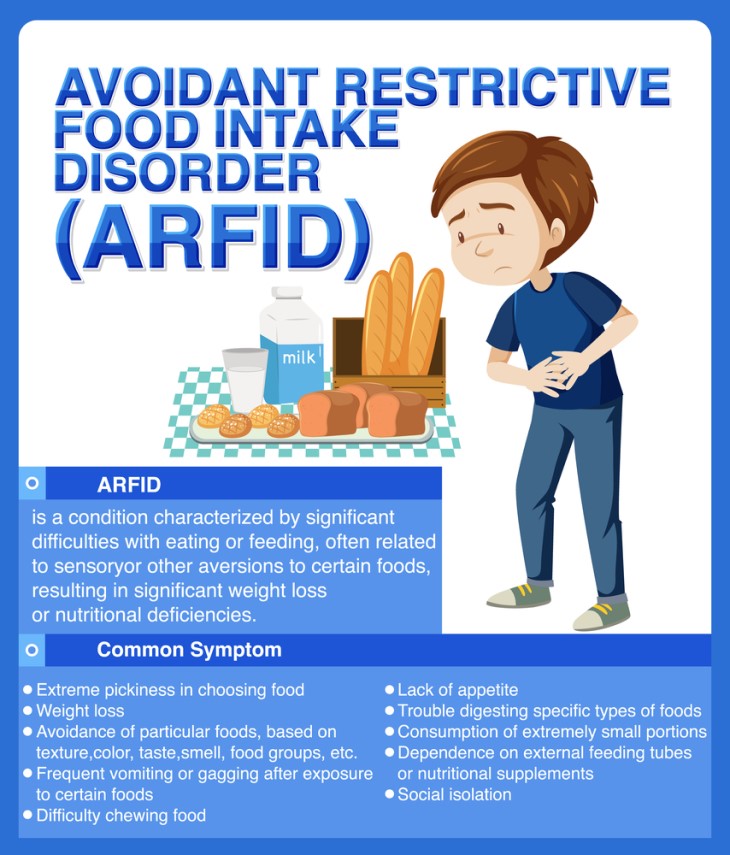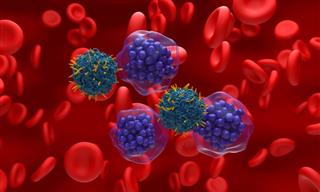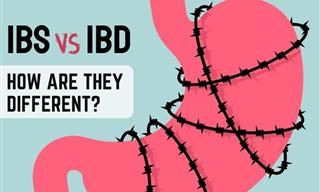
In the ever-evolving realm of psychological disorders, Avoidant Restrictive Food Intake Disorder (ARFID) has emerged as a puzzling newcomer in recent years. Once lumped under the broad label of "Selective Eating Disorder," ARFID distinguishes itself from more widely recognized conditions like anorexia by avoiding any emotional entanglement with body image or fears of becoming overweight.
Diagnosing ARFID
The Diagnostic and Statistical Manual of Mental Disorders, Fifth Edition (DSM-5), serves as the cornerstone for identifying ARFID. According to this clinical bible, the condition manifests as an eating or feeding disturbance that results in persistent failure to meet appropriate nutritional and energy needs. This disturbance is associated with one or more of the following: significant weight loss, nutritional deficiency, dependence on enteral feeding (tube feeding) or oral supplements, and a marked interference with psychosocial functioning.

Critically, the diagnosis of ARFID dismisses conditions where the symptoms are better explained by lack of available food or culturally sanctioned practices. It also excludes the presence of anorexia nervosa, bulimia nervosa, or any other medical or mental conditions that could potentially cause the symptoms. In essence, ARFID stands as a unique eating disturbance requiring its own set of diagnostic considerations and interventions.
Risk Factors:
While our understanding of ARFID is still burgeoning, several risk factors have been identified. Individuals with autism spectrum conditions, Attention Deficit Hyperactivity Disorder (ADHD), and intellectual disabilities are more susceptible to developing ARFID. In addition, children who exhibit severe or enduring picky eating behaviors appear more likely to transition into ARFID as they age. Anxiety disorders frequently accompany ARFID, often further complicating the diagnostic and treatment landscape.
It's important to underscore that risk factors can vary substantially between individuals. This means that two people with ARFID might have vastly different experiences, perspectives, and symptoms—a reflection of the complex interplay between biological, psychological, and sociocultural elements.

Warning Signs and Symptoms:
The symptoms of ARFID are as diverse as they are concerning. On the surface, dramatic weight loss and gastrointestinal issues may serve as the most visible indicators. However, closer examination reveals an array of other signs such as food texture aversions, fears of choking or vomiting, and a narrowing range of accepted foods over time.
Psychological symptoms, including lack of interest in food and non-specific complaints around mealtime, are common. Notably, there is no body-image disturbance or fears of weight gain—symptoms often associated with other eating disorders—further underscoring the unique nature of ARFID.
The Way Forward: A Daunting Reality and Gaps in Understanding
ARFID is more than just an intriguing psychological curiosity; it poses severe and life-threatening health risks. Due to insufficient nutrient intake, the body goes into an energy-conservation mode, leading to a range of dire consequences of electrolyte imbalances to cardiac arrest.
Despite the depth of our current understanding, numerous gaps remain. The etiology and long-term impacts of ARFID are yet to be fully understood, and the quest for effective treatment options is ongoing. These lingering questions underscore the imperative for continued research and clinical focus.

Tips That Help Your Children Develop Healthy Eating Habits
It’s vital for kids to learn the importance of nutrition early and these 8 tips will help you get them to eat fruits and veggies every day!

10 Terrific Health Benefits of Chives
The myriad health benefits of Chives have been known since the days of the Roman Empire.

Guide: What to Feed a Baby at Every Age
Not all solid foods are suitable for every stage, which is why we have created a guide to help you feed your baby according to their age.

Solving 10 Food-Related Problems Some Parents Face
we have gathered 10 common problems and the best solutions to address them, assisting you to get through each family dinner or feeding the baby with ease.
 2:59
2:59
Dr. Explains: How Much Antioxidants Do Our Foods Contain?
Do you think you know which are the best lentils? Or what is the most recommended apple variety in terms of antioxidants? There are quite a few surprises here...

Guide: How to Meditate With Your Children
This guide will instruct you on how to do easy meditation techniques with your children and grandchildren.

How to Check Your Mouth for Mouth and Throat Cancer
This guide will explain the risk factors, show you a step-by-step self-exam procedure, describe common symptoms to watch for, and advise when to seek medical care.

Is Running Better on a Soft or Hard Surface?
We examined the issue of running on hard or soft surfaces and which is better, and the answer is here before you.

Health Tip: Is the Mercury in Fish a Real Danger to You?
In this article we'll simplify the issue of mercury in fish, answer this question for you now, and show you exactly what you need to do.
 16:23
16:23
Stiff Ankles? Fix Them Fast with These 3 Exercises
Struggling with stiff ankles? Try these simple exercises today.
 13:15
13:15
The BEST Exercises to Relieve Bunion Pain
These simple exercises are designed to reduce the pain caused by bunions and help slow down the progression of the condition.
 5:10
5:10
Why Are Humans SO Prone to Sinus Infections?
Sinus infections are more common in humans than in any animal species, but why? A strange biological quirk may be to blame...

The Silent Bite: Chagas Disease Spreading in the USA
In recent years, the narrative surrounding Chagas disease in the US has shifted significantly...
 12:03
12:03
Ensure a Good Night’s Sleep with This Easy Yoga Practice
Trouble unwinding and falling asleep at night? Try following this easy yoga tutorial

No More Chemo: A New Treatment for leukemia
Until recently, patients whose leukemia advanced after these two lines of treatment faced poor prognoses. This has now changed thanks to advancements in treatment.

Top 5 Killers in the West: How Lifestyle Drives Death
The 5 top causes of death in the developed world and the reasons leading to them.

Un-Hunch Your Shoulders Easily With These 7 Exercises!
Got hunched shoulders? This guide will help you improve your posture.
 16:03
16:03
Anxiety and Grief Can Cause Profound Cardiac Injury
‘A broken heart’ is one expression we might want to take more literally. As thoroughly explained in this incredibly insightful lecture, the effects of heartbreak, as well as other emotions, both positive and negative, all leave a very real, physical

8 Important Digestive Symptoms We Must All Know About
The following eight points cover common digestive system issues that are actually signals of more serious problems

IBS versus IBD - Symptoms and Key Differences
Let’s compare and contrast IBS and IBD in this educational article.
 5:18
5:18
Test Your Hearing: Can You Hear that Last Sound?
As we grow older, we can hear less and less sound frequencies. How young are your ears? Take this audio test.

Studies Show: How Work Can Shorten Our Lifespan
You are invited to learn about these studies and discover how many working hours could actually endanger your life.

9 Low-Calorie Cereals That'll Maintain Your Weight
The 9 most recommended grains for a low-carb diet and for maintaining weight and general health.

The One Common Mistake That Makes Our Earlobes Longer
Here, the skin's aging process becomes strikingly visible: loss of volume, decreased elasticity, and gradual elongation that reshapes the ear's appearance.
 5:00
5:00
50+? Try This Exercise for Stronger Legs!
Improve your balance and leg strength with this one simple exercise.
 5:49
5:49
Avoid These Common Mistakes When Buying Canned Foods
Before you buy your next lot of canned foods, make sure you watch this video...

Discover the Many Health Benefits of Massage Therapy
Learn about the different types of massage therapy, each dealing with a different health problem.
 8:01
8:01
The Main Mineral Deficiency Causing Aging Spots
Find out what causes aging spots and how you can treat them.
 7:16
7:16
WARNING: What NOT to Eat for Better Health After 50
If you’re over 50, knowing what to avoid can help you stay healthier for longer.
 22:12
22:12
10 Life-Changing Hacks for Better Glucose Levels
Transform your health with genius glucose tips.
 3:14
3:14
Let's Talk About the Anti-Cancer Benefit of Sweet Potatoes
Lets Talk About the Anti-Cancer Potential of Sweet Potatoes

Which Drinks Increase Your Risk of Stroke?
Let’s see what exactly these studies say, which drinks are worth drinking more of, and which ones are best to avoid.
 5:11
5:11
Do Potatoes Lead to Diabetes? An Expert Explains
Watch health expert Dr. Michael Greger explaining whether potatoes should be a cause for concern, what recent studies reveal, and how all of this relates to French fries and deep frying.

Age-Related Macular Degeneration: How to Treat It
The diagnostic methods, the importance of early detection, and new treatments that are changing how we manage this disease

Do Earphones Truly Ruin Our Hearing?
A recent analysis by the Acoustical Society of America shows that the younger generation is facing serious damage to their hearing ability
 4:31
4:31
Is Your Supplement Safe? Try These Simple Tests to Know
How can you tell if a supplement is a fake? Watch this video to find out...
 13:05
13:05
Keep Your Heart Healthy With This Indoor Walking Routine
This 10-minute indoor walking workout is an easy way for seniors to keep your body moving.
 8:54
8:54
Did You Know Your Body Could Do These Incredible Things?
The human body is a fascinating and unique in so many ways. Here are some cool things about your body you probably didn't know.
 7:28
7:28
Is This a Radical New Way to Treat the Spine?
Paralysis as a result of spinal cord injury is a problem that the medical world has been trying to solve for a long time. Thankfully, the solution may be in sight...
 11:58
11:58
5 Ways to Improve Your Lung Capacity
This enlightening video will teach you to breathe more effectively by teaching you 5 simple lessons.
 10:56
10:56
12 Common Myths About Yoga DEBUNKED By Experts
Do you have to be flexible to practice yoga? Is yoga safe for pregnant women? Here are 12 common myths about yoga you should not buy into!
 2:54
2:54
The Real Reason You Pee More in the Winter Months
Do you find yourself rushing to the bathroom more often during winter? There's a reason for it.

11 Health Benefits of the Glasswort Plant
In addition to reducing sodium intake, salicornia has several other health benefits that we think you should know about...
 6:51
6:51
Easy Exercises to Strengthen Your Memory
Qi Gong is an ancient Chinese practice that can help improve memory. Find out how...
 15:14
15:14
Feeling Off? 8 Signs Your Cortisol May Be High
How do you know if your cortisol is high?
 13:03
13:03
Easy Upper Body Workout to Help Seniors Stay Active
Here's an easy and effective workout for seniors to build their upper body strength.
To enable your Ad-Free Subscription, please fill the fields below
Your subscription was successful, now you can enjoy an ad-free experience!! Note: To make sure you get no ads, please make sure to log in to your account. If you are logged in already, then refresh the page. The subscription can be cancelled at any time.


